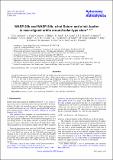WASP-20b and WASP-28b : a hot Saturn and a hot Jupiter in near-aligned orbits around solar-type stars
View/
Date
03/2015Author
Funder
Grant ID
ST/J001651/1
ST/I000666/1
PP/D000890/1
ST/M001296/1
ST/G001006/1
PP/F000065/1
Keywords
Metadata
Show full item recordAbstract
We report the discovery of the planets WASP-20b and WASP-28b along with measurements of their sky-projected orbital obliquities. WASP-20b is an inflated, Saturn-mass planet (0.31M; 1.46R) in a 4.9-day, near-aligned (λ = 12.7 ± 4.2) orbit around CD-24 102 (V = 10.7; F9). Due to the low density of the planet and the apparent brightness of the host star, WASP-20 is a good target for atmospheric characterisation via transmission spectroscopy. WASP-28b is an inflated, Jupiter-mass planet (0.91M; 1.21R) in a 3.4-day, near-aligned (λ = 8 ± 18) orbit around a V = 12, F8 star. As intermediate-mass planets in short orbits around aged, cool stars (7 Gyr and 6000 ± 100 K for WASP-20; 5 Gyr and 6100 ± 150 K for WASP-28), their orbital alignment is consistent with the hypothesis that close-in giant planets are scattered into eccentric orbits with random alignments, which are then circularised and aligned with their stars' spins via tidal dissipation.
Citation
Anderson , D R , Collier Cameron , A , Hellier , C , Lendl , M , Lister , T A , Maxted , P F L , Queloz , D , Smalley , B , Smith , A M S , Triaud , A H M J , Brown , D J A , Gillon , M , Neveu-Vanmalle , M , Pepe , F , Pollacco , D , Ségransan , D , Udry , S , West , R G & Wheatley , P J 2015 , ' WASP-20b and WASP-28b : a hot Saturn and a hot Jupiter in near-aligned orbits around solar-type stars ' , Astronomy & Astrophysics , vol. 575 , A64 . https://doi.org/10.1051/0004-6361/201423591
Publication
Astronomy & Astrophysics
Status
Peer reviewed
ISSN
0004-6361Type
Journal article
Description
Funding for WASP comes from consortium universities and from the UK’s Science and Technology Facilities Council. M. Gillon is a FNRS Research Associate. A. H. M. J. Triaud is a Swiss National Science Foundation fellow under grant number PBGEP2-145594.Collections
Items in the St Andrews Research Repository are protected by copyright, with all rights reserved, unless otherwise indicated.
Related items
Showing items related by title, author, creator and subject.
-
A prospective new diagnostic technique for distinguishing eruptive and noneruptive active regions
Pagano, Paolo; Mackay, Duncan H.; Yardley, Stephanie L. (2019-09-26) - Journal articleActive regions are the source of the majority of magnetic flux rope ejections that become coronal mass ejections (CMEs). To identify in advance which active regions will produce an ejection is key for both space weather ... -
From dense hot Jupiter to low-density Neptune : the discovery of WASP-127b, WASP-136b, and WASP-138b
Lam, K. W. F.; Faedi, F.; Brown, D. J. A.; Anderson, D. R.; Delrez, L.; Gillon, M.; Hébrard, G.; Lendl, M.; Mancini, L.; Southworth, J.; Smalley, B.; Triaud, A. H. M.; Turner, O. D.; Hay, K. L.; Armstrong, D. J.; Barros, S. C. C.; Bonomo, A. S.; Bouchy, F.; Boumis, P.; Collier Cameron, A.; Doyle, A. P.; Hellier, C.; Henning, T.; Jehin, E.; King, G.; Kirk, J.; Louden, T.; Maxted, P. F. L.; McCormac, J. J.; Osborn, H. P.; Palle, E.; Pepe, F.; Pollacco, D.; Prieto-Arranz, J.; Queloz, D.; Rey, J.; Ségransan, D.; Udry, S.; Walker, S.; West, R. G.; Wheatley, P. J. (2017-03-01) - Journal articleWe report three newly discovered exoplanets from the SuperWASP survey. WASP-127b is a heavily inflated super-Neptune of mass 0.18 ± 0.02 MJ and radius 1.37 ± 0.04 RJ. This is one of the least massive planets discovered by ... -
The well-aligned orbit of Wasp-84b : evidence for disk migration of a hot Jupiter
Anderson, D. R.; Triaud, A. H. M. J.; Turner, O. D.; Brown, D. J. A.; Clark, B. J. M.; Smalley, B.; Cameron, A. Collier; Doyle, A. P.; Gillon, M.; Hellier, C.; Lovis, C.; Maxted, P. F. L.; Pollacco, D.; Queloz, D.; Smith, A. M. S. (2015-02-10) - Journal articleWe report the sky-projected orbital obliquity (spin–orbit angle) of WASP-84 b, a 0.69 planet in an 8.52 day orbit around a G9V/K0V star, to be λ = −0.3 ± 1.7°. We obtain a true obliquity of ψ = 17.3 ± 7.7° from a measurement ...

